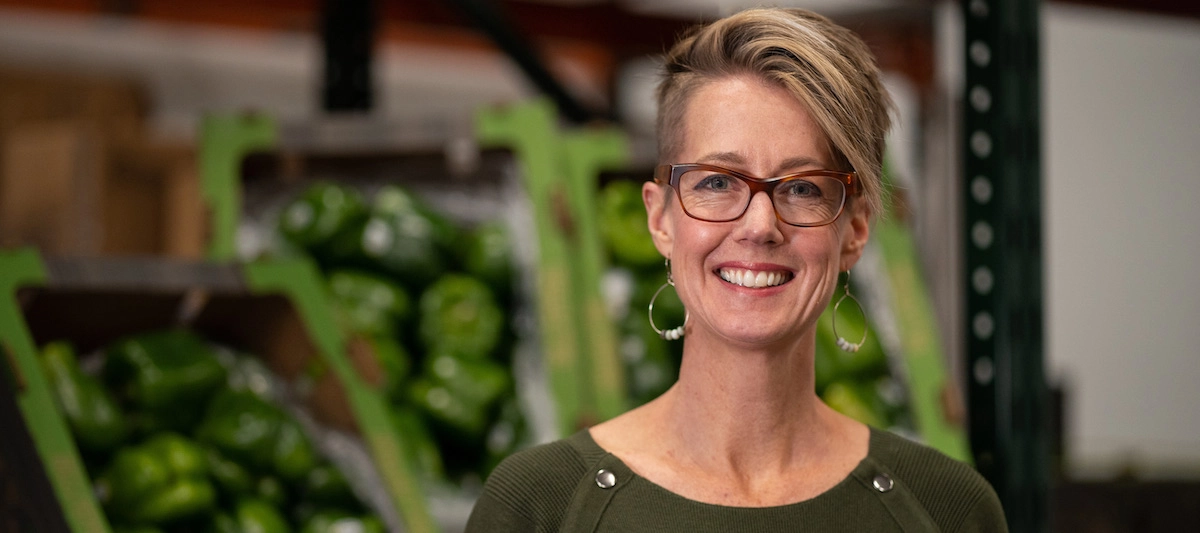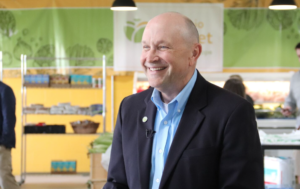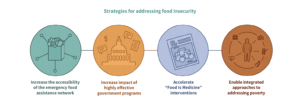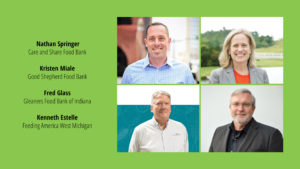To Erin Pulling, becoming CEO of Food Bank of the Rockies was a bit of a leap – she had never run such a large organization before and she didn’t know anything about food banking. At the same time, she couldn’t deny the feeling that she had landed in a “right place-right time” type of situation once she arrived.
After 24 years at a nearby non-profit that home-delivers medically tailored meals, she could justify a career change. Her time at Denver-based Project Angel Heart – including 14 years as CEO – had taught her the importance of a few key tenets – nutrition, equity and advocacy. As it turned out, Food Bank of the Rockies was ready to embrace those concepts too, despite not having a track record of doing so.
In fact, as she was putting forth her ideas on nutrition, equity and advocacy during her interview with the food bank, a board member had “slammed his hands on the table and said, ‘That’s what we’re talking about. We are so ready for this!’” shared Pulling, who became the food bank’s CEO in early 2019.
Since then, Pulling has been able to animate all three of those principles and then some, while also managing the shifts and pivots of the pandemic, leading her to be named Food Bank News’ 2022 Food Bank CEO of the Year.
Pulling’s tenure began with a long listening tour of the food bank’s partners, yielding a clear-eyed view of just how much work was needed to win over their trust and good will. “There was not a strong cultural mindset of customer service,” she allowed. A sense of scarcity was deeply embedded within the institution, affecting everything from the quality of food distributed to marketing, technology and human resources. “Our operations were very, very shoestring,” she said.
Pulling’s list of priorities for year one was substantial – install a new leadership team, overhaul basic operations to achieve best practices, institute a culture of responsive customer service, all while learning the business from the ground up. The groundwork was barely laid before the pandemic hit, creating another cascade of need. Within 48 hours of the Farmers to Families Food Box program being announced, the food bank acquired a new warehouse. It also added more cold storage, new vehicles and extra staff including a night shift.
In the end, Covid proved to be well-timed. By then, the food bank had its foundation in place and could steer the momentum and support generated by Covid toward innovative projects that it likely never would have considered previously. “Before Covid, we would have said, ‘That’s not what we do. That’s not our business,’” Pulling said. “And now our response is more like, ‘Why not?’”
Perhaps the best example of that “Why not?” attitude is the food bank’s Culturally Responsive Food Initiative, which has become a national model of how to support the ethnic preferences of clients. Dreamed up over a weekend and rolled out over about two years, the effort stands out for its broad scope and deep client input.
During the pilot phase, the food bank collected data from more than 700 clients, 111 partner agencies and 12 community organizations to identify the seven most prevalent cultures in its service area and their preferred foods. All of that data was rolled up into a comprehensive, $1 million a year program that helps partner agencies serve their ethnic communities through tools like food-sourcing lists by culture, guidance on the 15 most-common foods across cultures, and financial assistance to purchase the foods.
Pulling gave credit for the program’s creation to Chief Operating Officer Steve Kullberg, who in turn credited Pulling for building a team and environment that inspires innovation. “I’ve never been so supported in terms of the freedom to try new things,” Kullberg said, adding, “Erin is amazing – willing to listen and move quickly. It’s not a bureaucratic type of environment.”
The food bank tried something new again when the Farmers to Families Food Box program wound down, bringing an abrupt halt to the 160,000+ boxes of fresh food it had been receiving every month. “Our partner agencies really appreciated the high quality fresh produce, so we were not going to just let that end,” Pulling said.
Instead, it started FRESH, which replaces 100% of the produce (not the dairy or meat) that the food bank had received through the Farmers to Families program. The $3.6 million a year program sources produce from 25 in-state growers as well as out-of-state producers, with the goal of distributing 1.2 million pounds of fruits and vegetables a month throughout its service area. The food bank works with its partners to deliver pallet-loads of produce in ways and at times that are most convenient. Eventually, the food bank would like to have produce make up 50% of all the food it distributes, up from about a third currently.
In another outgrowth of listening to its partners, the food bank has eliminated all fees related to transporting and delivering food (like many food banks, it had never charged fees for produce). The move, which aligns with the actions of a growing number of food banks, removed about $1 million in annual revenue from the bottom line. “It’s a hit, but we have more fundraising capacity than any of our hunger relief partners,” Pulling said, noting the elderly nun who recently gave her a talking-to about fees. “It was our time to show that we’ve heard and we’re responding.”
Food Bank of the Rockies had a history of avoiding engagement in public policy, but Pulling has been making strides in that area as well. The board just approved its third policy agenda and has for the first time clarified the ways in which it would like to partner with community organizations outside of hunger relief as it seeks to address root causes. Again, listening will be key. “I feel like the bigger and more successful we are, the more we need to be showing up to these meetings and keeping our mouths shut and listening,” Pulling said.
An avid runner who recently completed a rim to rim to rim run through the Grand Canyon (that’s longer than a marathon and as arduous as it sounds), Pulling is utterly practical about what she’s accomplished so far and what is left to do. Despite the kudos the food bank has received for its Culturally Responsive Food Initiative, Pulling is non-plussed. “I don’t see it as very innovative. We just asked questions, we listened and we adjusted.”
Listening to staff is also becoming more a part of the culture of the food bank. Earlier this year, for example, the food bank began paying an extra $200 to $250 a month to staffers who are fluent in a second or third language. But in Pulling’s view, listening to clients in particular remains a work in progress. “We’re not doing a fantastic job of it,” she said. “Our overall process of how we listen to clients – that’s something that we’re not done with yet.” – Chris Costanzo
Like what you’re reading?
Support Food Bank News
This article was made possible by the readers who support Food Bank News, a national, editorially independent, nonprofit media organization. Food Bank News is not funded by any government agencies, nor is it part of a larger association or corporation. Your support helps ensure our continued solutions-oriented coverage of best practices in hunger relief. Thank you!
Connect with Us:










